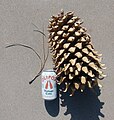
Pinus balfouriana, the foxtail pine, is a rare high-elevation pine that is endemic to California, United States. It is closely related to the Great Basin and Rocky Mountain bristlecone pines, in the subsection Balfourianae.

Pinus sabiniana, with vernacular names including towani pine, foothill pine, gray pine, bull pine, and digger pine, is a pine endemic to California in the United States. Some sources discourage using the name "digger pine," considering it pejorative.
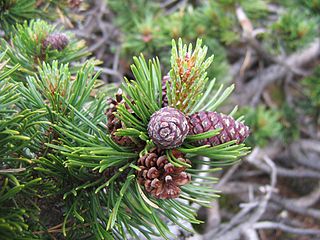
Pinus mugo, known as dwarf mountain pine, mountain pine, scrub mountain pine, Swiss mountain pine, bog pine, creeping pine, or mugo pine, is a species of conifer, native to high elevation habitats from southwestern to Central Europe and Southeast Europe.

Pinus lambertiana is the tallest and most massive pine tree, and has the longest cones of any conifer. The species name lambertiana was given by the Scottish botanist David Douglas, who named the tree in honour of the English botanist, Aylmer Bourke Lambert. It is native to coastal and inland mountain areas along the Pacific coast of North America, as far north as Oregon and as far south as Baja California in Mexico.

Pinus jeffreyi, also known as Jeffrey pine, Jeffrey's pine, yellow pine and black pine, is a North American pine tree. It is mainly found in California, but also in the westernmost part of Nevada, southwestern Oregon, and northern Baja California. It is named in honor of its botanist documenter John Jeffrey.

Pinus flexilis, the limber pine, is a species of pine tree-the family Pinaceae that occurs in the mountains of the Western United States, Mexico, and Canada. It is also called Rocky Mountain white pine.

Pinus contorta, with the common names lodgepole pine and shore pine, and also known as twisted pine, and contorta pine, is a common tree in western North America. It is common near the ocean shore and in dry montane forests to the subalpine, but is rare in lowland rain forests. Like all pines, it is an evergreen conifer.

Pinus pumila, commonly known as the Siberian dwarf pine, dwarf Siberian pine, dwarf stone pine, Japanese stone pine, or creeping pine, is a tree in the family Pinaceae native to northeastern Asia and the Japanese isles. It shares the common name creeping pine with several other plants.
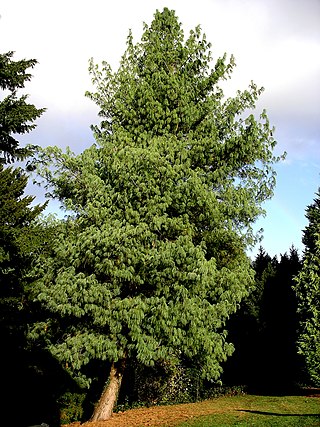
Pinus wallichiana is a coniferous evergreen tree native to the Himalaya, Karakoram and Hindu Kush mountains, from eastern Afghanistan east across northern Pakistan and north west India to Yunnan in southwest China. It grows in mountain valleys at altitudes of 1800–4300 m, reaching 30–50 m (98–164 ft) in height. It favours a temperate climate with dry winters and wet summers. In Pashto, it is known as Nishtar.

Pinus virginiana, the Virginia pine, scrub pine, Jersey pine, possum pine, is a medium-sized tree, often found on poorer soils from Long Island in southern New York south through the Appalachian Mountains to western Tennessee and Alabama. The usual size range for this pine is 9–18 m, but can grow larger under optimum conditions. The trunk can be as large as 20 inches diameter. This tree prefers well-drained loam or clay, but will also grow on very poor, sandy soil, where it remains small and stunted. The typical life span is 65 to 90 years.

The knobcone pine, Pinus attenuata, is a tree that grows in mild climates on poor soils. It ranges from the mountains of southern Oregon to Baja California with the greatest concentration in northern California and the Oregon-California border.

Pinus muricata, the bishop pine, is a pine with a very restricted range: mostly in California, including several offshore Channel Islands, and a few locations in Baja California, Mexico. It is always on or near the coast.

Pinus ponderosa, commonly known as the ponderosa pine, bull pine, blackjack pine, western yellow-pine, or filipinus pine is a very large pine tree species of variable habitat native to mountainous regions of western North America. It is the most widely distributed pine species in North America.

The stone pine, botanical name Pinus pinea, also known as the Italian stone pine, Mediterranean stone pine, umbrella pine and parasol pine, is a tree from the pine family (Pinaceae). The tree is native to the Mediterranean region, occurring in Southern Europe and the Levant. The species was introduced into North Africa millennia ago, and is also naturalized in the Canary Islands, South Africa and New South Wales.

Abies concolor, the white fir, concolor fir, or Colorado fir, is a coniferous tree in the pine family Pinaceae. This tree is native to the mountains of western North America, including the Cascade Range and southern Rocky Mountains, and into the isolated mountain ranges of southern Arizona, New Mexico, and Northern Mexico. It naturally occurs at elevations between 900 and 3,400 metres.

California mixed evergreen forest is a plant community found in the mountain ranges of California and southwestern Oregon.
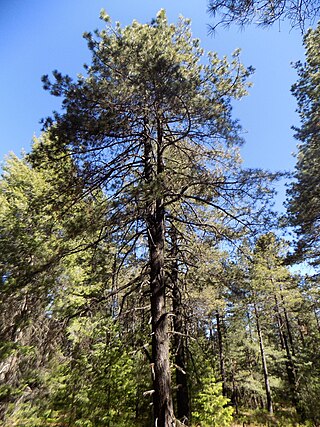
Pinus durangensis, the Durango pine, is a pine tree species endemic to the Sierra Madre Occidental mountain range of north-western Mexico.
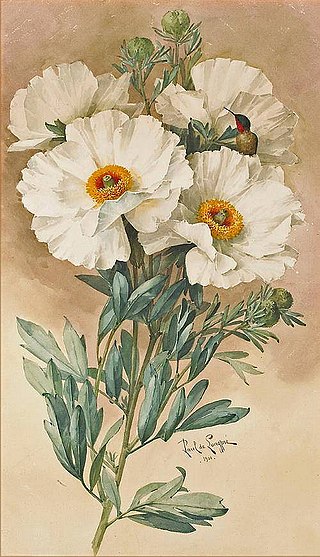
Romneya coulteri, the Coulter's Matilija poppy or California tree poppy, is a perennial species of flowering plant in the poppy family Papaveraceae. Native to southern California, USA, and Baja California, Mexico, it grows in dry canyons in chaparral and coastal sage scrub plant communities, sometimes in areas recently burned. It is a popular ornamental plant, kept for its large, showy flowers.
The Mediterranean California lower montane black oak–conifer forest is a major forest association and ecosystem of the California mixed evergreen forest bioregion in certain mountain ranges in California and southern Oregon in the Western United States; and Baja California in northwest Mexico.

Pinus washoensis, the Washoe pine, is a rare, semi-disputed species of large-sized conifer in the family Pinaceae. The species was described by Herbert Louis Mason and William Palmer Stockwell in 1945. It is in the Pinussubsect. Ponderosae with the Ponderosa pine.









